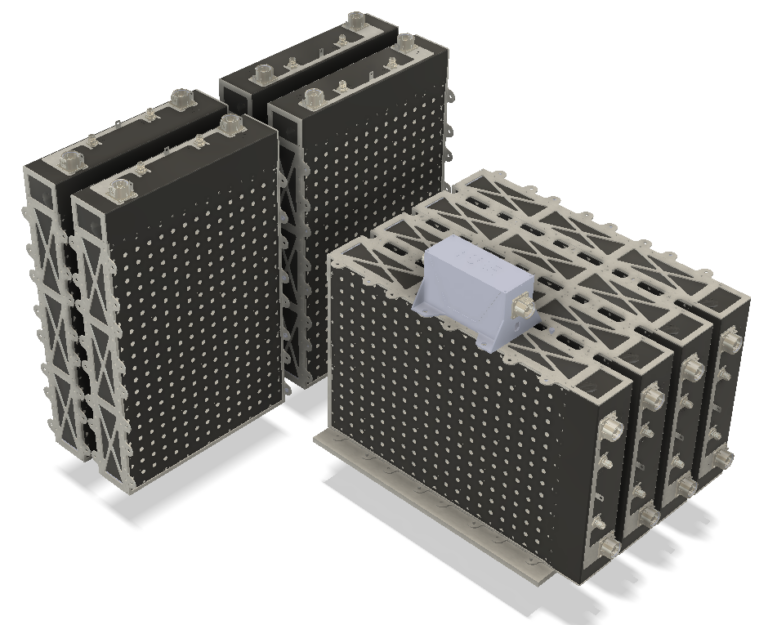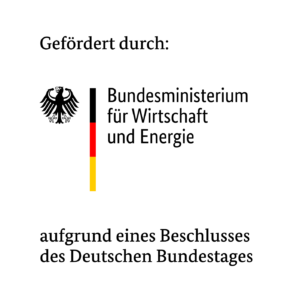
Larger batteries made of lithium-ion cells are gradually finding their way into aircraft. Until now, battery systems have been designed elaborately and specifically for individual applications. In particular, the desire to install a lot of battery capacity in an unchangeable installation space requires individual solutions. However, this causes high costs. Therefore, we have set ourselves the goal of bringing a modular battery concept into our portfolio, which will enable more aircraft manufacturers to enter this clean technology through lower costs and shorter development times.
The modular battery system should have the following features:
- Scalability of voltage
- Scalability of capacity and power
- Suitable scalable battery management system
- Possibility to install individual modules distributed in the aircraft
- Fulfillment of the minimum requirements for successful authorization as an aircraft component
In the project „Safe and quiet flying through a high degree of automation and electric drives using e-tow as an example“ (SiFlA), a modular battery concept will be developed and built.
The modular concept will significantly reduce the cost and time of battery integration. In addition, these battery modules can be replaced quickly and easily. In cooperation with Garrecht Avionik GmbH, the Instutit für Flugmechanik und Flugregelung (University of Stuttgart) and the Institut für Flugzeugbau (University of Stuttgart), the modular battery concept and the appropriate charging technology will be designed, built and integrated into the e-Genius research aircraft. This will test the practical suitability of the battery modules.
Funding code: 20Q1938A, funded by the Bundesministerium für Wirtschaft und Energie.
Project duration: June 2021 to August 2024.
Possible aircraft applications for electrification
The selection of aircraft is important for the design of a modular battery system. That is, which aircraft missions lend themselves well to electrification because the aircraft does not have to travel long distances or carry large loads. For example, tow operations or trainer flight operations lend themselves well to electrification, the aircraft stay close to the airport and flight times are short.
In this context, it is important to select aircraft that are not only suitable for the application, but also have the best possible prerequisites for electrification. These are:
- Good aerodynamics
- Low empty weight with high maximum take-off weight
In the field of light aircraft (LSA or CS22), there are good examples of aircraft that can be electrified.
For the estimation of the required battery capacity, the propulsion configurations of the reference aircraft are adopted. Possible efficiency improvements by changing the positioning of the propellers or distributed electric propulsion systems are not considered. These changes would significantly increase the certification effort and make commercial use of the batteries there unlikely within the next few years.
The Battery System
A modular design is planned, which will enable a wide range of light aircraft to be electrified with as little effort as possible. Due to its high scalability, the system can be flexibly adapted to the respective aircraft type. The modular configuration of the system enables high voltage systems with a nominal voltage of up to 800 V to be implemented, which can provide up to 240 kW peak power and 80 kWh capacity. This will even enable longer electric flights. Aircraft performance also benefits from high peak power and adequate reserves. Initially the electric motor glider „e-Genius“ from the University of Stuttgart will be equipped with a 400 V system as part of the publicly funded cooperation project „SiFlA“.
The following parameters will be implemented on the module level:
- Nominal voltage 50,4 V (max. 60 V)
- Capacity 100 Ah (5 kWh)
- Weight 24 kg
- Dimensions: 580 mm x 340 mm x 80 mm
Due to the high scalability, both system voltage and capacity can be individually adjusted. Fully redundant systems to increase reliability are also possible.
To control and monitor the battery system a battery managment system with master-slave architecture is used, which also includes a flexibly adaptable interface for communication with the aircraft systems. All necessary infrastructure, such as switches, fuses and a pre-charging circuit are already integrated into the battery system.

